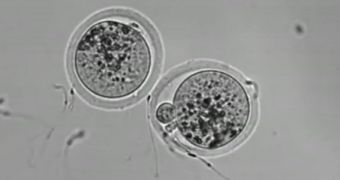Scientists with the Icahn School of Medicine (ISM) at Mount Sinai in New York announce the discovery of a protein that researchers have been looking for for years. The fertility protein is largely the reason why sperm can attach itself to the surface of female eggs, allowing for conception to occur.
The new discovery could pave the way for the development of new methods for birth control, as well as lead to the creation of advanced treatments against infertility in women, says expert Paul Wassarman, who is a biochemist and developmental biologist at ISM. Details of the study appear in the April 16 issue of the top scientific journal Nature.
Back in 2005, researchers discovered a protein called Izumo1 on the surface of sperm cells that enabled the latter to bind to female eggs. However, the molecule's counterpart on the surface of egg cells remained elusive. Over the past 9 years, scientists have been trying to identify this mysterious molecule. The new research finally managed to discover and characterize the protein.
The research group was led by biochemist Gavin Wright from the Wellcome Trust Sanger Institute in Hinxton, the UK. The expert says that the second protein finally completes the picture of what happens when the two types of cells join to begin the process of fertilization. He adds that finding the egg protein was a very complicated process.
In a study conducted on mice, the research group was able to discover that the protein folate receptor 4 is responsible for binding to Izumo1. Scientists are now proposing that this molecule be renamed Juno, after the Roman goddess of fertility. Identifying the exact role Juno played in fertilization was difficult because the connection between this molecule and Izumo1 was relatively weak, Nature News reports.
The new study was also able to establish that the Juno protein exists in other mammals as well, including humans. Without Izumo1 and Juno, sperm and egg cells cannot fuse and fertilization cannot occur. In mice, females that lacked the Juno molecule were otherwise healthy, but could not reproduce at all. Interestingly, Juno also plays a role in allowing just a single sperm cell to fuse with an egg cell.
The team found that, just 30 to 45 minutes following fertilization, the protein disappeared from the surface of egg cells entirely, therefore making it impossible for other sperm cells to bind. This discovery has important implications for fertility treatments. Tests could be developed whereby women could check to see if they have missing or defective Juno proteins.
The actions of Juno have not yet been studied in relation to fertility, but such investigations are definitely upcoming, researchers comment. Another implication of this study is that scientists may be able to develop new contraceptive drugs that would work by interfering with the structure or function of the Juno-Izumo1 complex, preventing fertilization.

 14 DAY TRIAL //
14 DAY TRIAL //